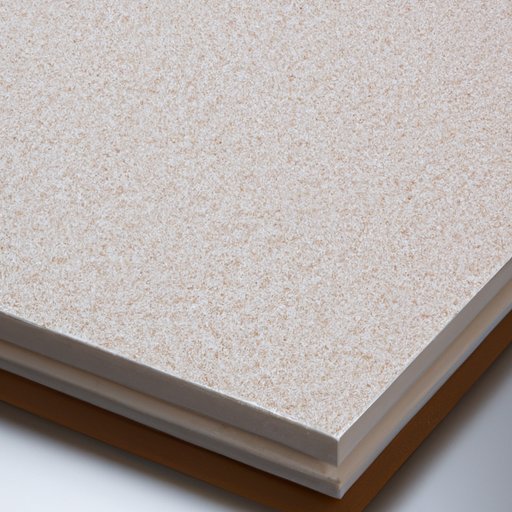Introduction
Ceiling tiles are a decorative and functional component of any home or office space. They provide insulation, sound absorption, and can even add a touch of style to a room. But what are these tiles made of? This article will explore the different materials used to make ceiling tiles and provide an overview of the pros and cons of each.

Exploring the Different Materials Used to Make Ceiling Tiles
When it comes to ceiling tiles, there are a variety of materials that can be used. Common materials include mineral fibers, plastic, and wood.
Mineral Fibers
Mineral fibers are one of the most common materials used to make ceiling tiles. These fibers are created from natural minerals such as asbestos, clay, and gypsum. The fibers are then bound together with resins and adhesives to form a durable material. Mineral fiber tiles are popular because they are relatively lightweight and inexpensive, and they offer good insulation and sound absorption properties.
Plastic
Plastic is another popular material used in the manufacture of ceiling tiles. Plastic tiles are usually made of PVC (polyvinyl chloride) or ABS (acrylonitrile butadiene styrene). They are lightweight, easy to install, and available in a variety of colors and patterns. Plastic tiles are also moisture-resistant and fire-retardant, making them ideal for areas where moisture or fire could be a concern.
Wood
Wood is also sometimes used to make ceiling tiles. Wood tiles can be made from a variety of hardwoods, including oak, cedar, and pine. They are often stained or painted to give them a unique look. Wood tiles are more expensive than other materials, but they can add a natural warmth and beauty to a room.

A Guide to the Different Types of Ceiling Tiles and Their Composition
Now that we’ve explored the different materials used to make ceiling tiles, let’s take a look at some of the different types of ceiling tiles and their composition.
Acoustical Ceiling Tiles
Acoustical ceiling tiles are designed to absorb sound. They are usually composed of mineral fibers and can be installed directly onto a ceiling grid system. Acoustical ceiling tiles are popular in offices and other commercial spaces, as they help reduce noise levels.
Drop-In Ceiling Tiles
Drop-in ceiling tiles are suspended from a metal grid system and are typically made of mineral fiber or plastic. They are easy to install and provide a clean, finished look. Drop-in ceiling tiles are popular in residential settings, as they can easily be removed and replaced if necessary.
Glue-Up Ceiling Tiles
Glue-up ceiling tiles are designed to be installed directly onto a flat surface. They are usually made of plastic or wood, and they can be painted or stained to match your décor. Glue-up ceiling tiles are popular in bathrooms and other wet environments, as they are waterproof and easy to clean.
How Are Ceiling Tiles Constructed?
The construction process for ceiling tiles varies depending on the type of tile and the material used. Generally speaking, the manufacturing process involves molding, cutting, and shaping the material into the desired shape. Once the tiles have been constructed, they must be installed. Installation typically involves attaching the tiles to a grid system or directly to a flat surface.
Pros & Cons of Different Ceiling Tile Materials
Each material used to make ceiling tiles has its own advantages and disadvantages. Let’s take a look at the pros and cons of each material.
Mineral Fibers
Pros: Lightweight, inexpensive, good insulation and sound absorption properties.
Cons: Can be difficult to install, may contain hazardous materials.
Plastic
Pros: Lightweight, easy to install, moisture-resistant and fire-retardant.
Cons: Limited color and pattern options, can be flimsy.
Wood
Pros: Natural warmth and beauty, durable.
Cons: Expensive, can be difficult to install.
What Are the Best Ceiling Tiles for Sound Absorption?
If you’re looking for ceiling tiles that offer good sound absorption, you should consider acoustical ceiling tiles or drop-in ceiling tiles. Acoustical ceiling tiles are specifically designed to absorb sound, so they are ideal for offices and other commercial spaces. Drop-in ceiling tiles can also provide good sound absorption, but they are not as effective as acoustical ceiling tiles.
An Overview of the Most Popular Ceiling Tile Materials
Now that we’ve explored the different materials used to make ceiling tiles and the pros and cons of each, let’s take a quick look at the most popular ceiling tile materials.
Mineral Fibers
Mineral fibers are the most common material used to make ceiling tiles. They are lightweight, inexpensive, and offer good insulation and sound absorption properties. However, they can be difficult to install and may contain hazardous materials.
Plastic
Plastic is another popular material used for ceiling tiles. Plastic tiles are lightweight, easy to install, and moisture-resistant. However, they are limited in terms of color and pattern options, and can be flimsy.
Wood
Wood is also occasionally used to make ceiling tiles. Wood tiles can add a natural warmth and beauty to a room, but they are more expensive and can be difficult to install.
Conclusion
Ceiling tiles are an important part of any home or office, providing insulation, sound absorption, and style. This article explored the different types of materials used to make ceiling tiles, from mineral fibers to wood, and provided an overview of the pros and cons of each. Whether you’re looking for a stylish addition to your home or office, or just want to reduce noise levels, ceiling tiles are a great choice.


